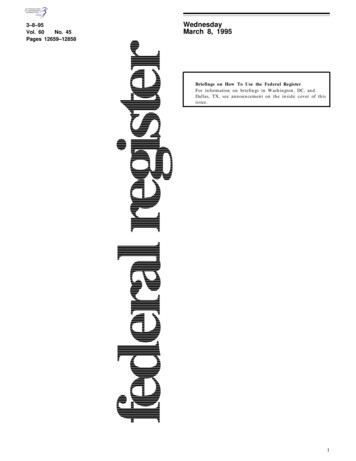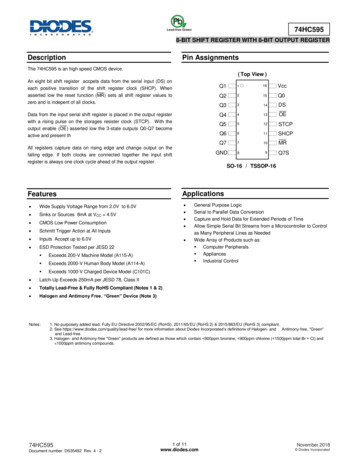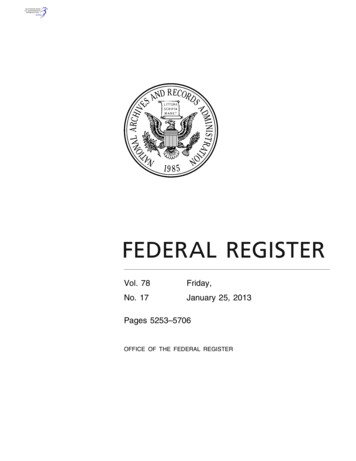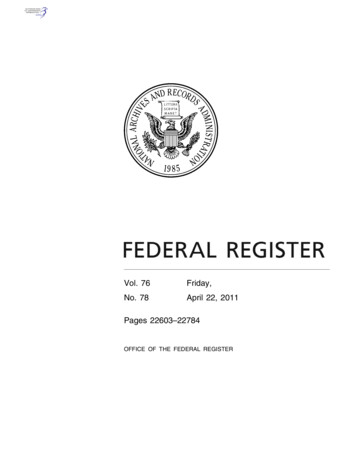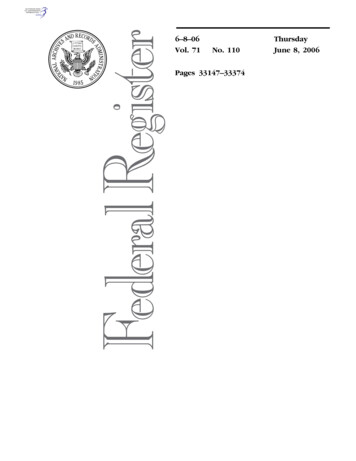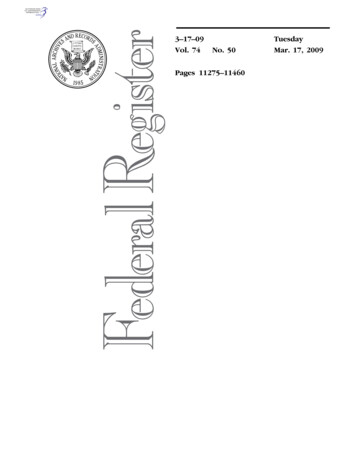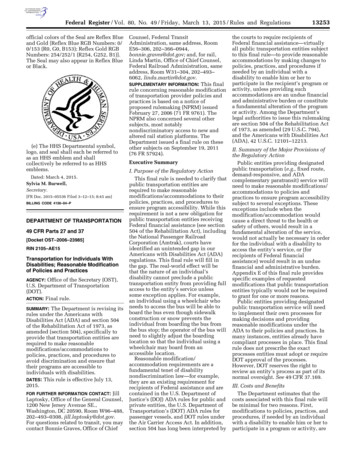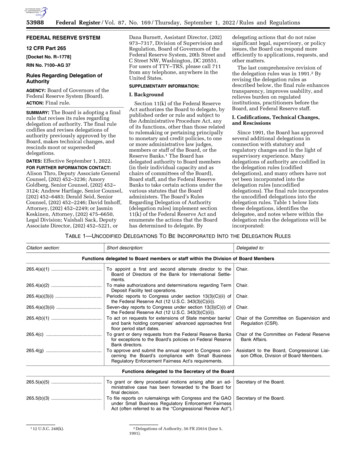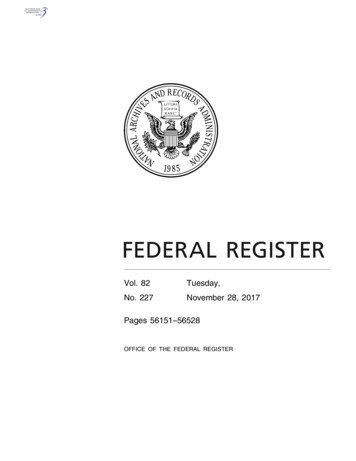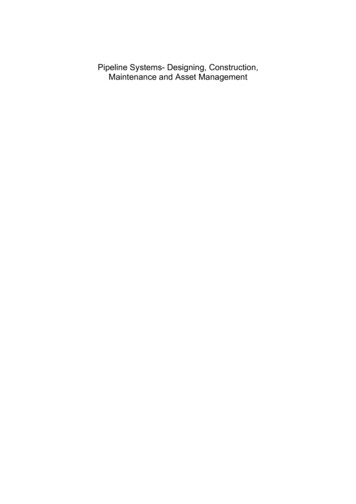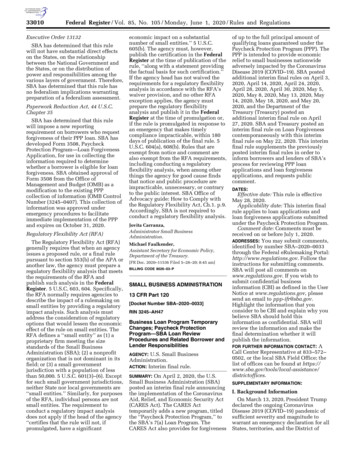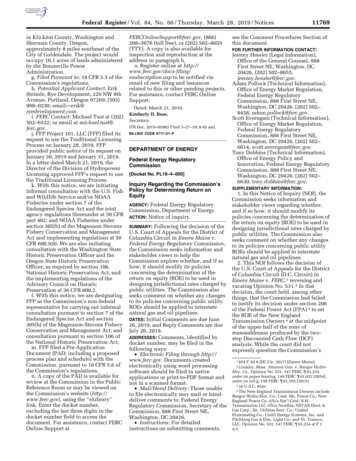
Transcription
amozie on DSK9F9SC42PROD with NOTICESFederal Register / Vol. 84, No. 60 / Thursday, March 28, 2019 / Noticesin Klickitat County, Washington andSherman County, Oregon,approximately 8 miles southeast of theCity of Goldendale. The project wouldoccupy 16.1 acres of lands administeredby the Bonneville PowerAdministration.g. Filed Pursuant to: 18 CFR 5.3 of theCommission’s regulations.h. Potential Applicant Contact: ErikSteimle, Rye Development, 220 NW 8thAvenue, Portland, Oregon 97209; (503)998–0230; email—erik@ryedevelopment.com.i. FERC Contact: Michael Tust at (202)502–6522; or email at michael.tust@ferc.gov.j. FFP Project 101, LLC (FFP) filed itsrequest to use the Traditional LicensingProcess on January 28, 2019. FFPprovided public notice of its request onJanuary 30, 2019 and January 31, 2019.In a letter dated March 21, 2019, theDirector of the Division of HydropowerLicensing approved FFP’s request to usethe Traditional Licensing Process.k. With this notice, we are initiatinginformal consultation with the U.S. Fishand Wildlife Service and/or NOAAFisheries under section 7 of theEndangered Species Act and the jointagency regulations thereunder at 50 CFRpart 402; and NOAA Fisheries undersection 305(b) of the Magnuson-StevensFishery Conservation and ManagementAct and implementing regulations at 50CFR 600.920. We are also initiatingconsultation with the Washington StateHistoric Preservation Officer and theOregon State Historic PreservationOfficer, as required by section 106,National Historic Preservation Act, andthe implementing regulations of theAdvisory Council on HistoricPreservation at 36 CFR 800.2.l. With this notice, we are designatingFFP as the Commission’s non-federalrepresentative for carrying out informalconsultation pursuant to section 7 of theEndangered Species Act and section305(b) of the Magnuson-Stevens FisheryConservation and Management Act; andconsultation pursuant to section 106 ofthe National Historic Preservation Act.m. FFP filed a Pre-ApplicationDocument (PAD; including a proposedprocess plan and schedule) with theCommission, pursuant to 18 CFR 5.6 ofthe Commission’s regulations.n. A copy of the PAD is available forreview at the Commission in the PublicReference Room or may be viewed onthe Commission’s website (http://www.ferc.gov), using the ‘‘eLibrary’’link. Enter the docket number,excluding the last three digits in thedocket number field to access thedocument. For assistance, contact FERCOnline Support atVerDate Sep 11 201418:57 Mar 27, 2019Jkt 247001FERCOnlineSupport@ferc.gov, (866)208–3676 (toll free), or (202) 502–8659(TTY). A copy is also available forinspection and reproduction at theaddress in paragraph h.o. Register online at http://www.ferc.gov/docs-filing/esubscription.asp to be notified viaemail of new filing and issuancesrelated to this or other pending projects.For assistance, contact FERC OnlineSupport.Dated: March 21, 2019.Kimberly D. Bose,Secretary.[FR Doc. 2019–05903 Filed 3–27–19; 8:45 am]BILLING CODE 6717–01–PDEPARTMENT OF ENERGYFederal Energy RegulatoryCommission[Docket No. PL19–4–000]Inquiry Regarding the Commission’sPolicy for Determining Return onEquityFederal Energy RegulatoryCommission, Department of Energy.ACTION: Notice of inquiry.AGENCY:Following the decision of theU.S. Court of Appeals for the District ofColumbia Circuit in Emera Maine v.Federal Energy Regulatory Commission,the Commission seeks information andstakeholder views to help theCommission explore whether, and if sohow, it should modify its policiesconcerning the determination of thereturn on equity (ROE) to be used indesigning jurisdictional rates charged bypublic utilities. The Commission alsoseeks comment on whether any changesto its policies concerning public utilityROEs should be applied to interstatenatural gas and oil pipelines.DATES: Initial Comments are due June26, 2019, and Reply Comments are dueJuly 26, 2019.ADDRESSES: Comments, identified bydocket number, may be filed in thefollowing ways: Electronic Filing through http://www.ferc.gov. Documents createdelectronically using word processingsoftware should be filed in nativeapplications or print-to-PDF format andnot in a scanned format. Mail/Hand Delivery: Those unableto file electronically may mail or handdeliver comments to: Federal EnergyRegulatory Commission, Secretary of theCommission, 888 First Street NE,Washington, DC 20426. Instructions: For detailedinstructions on submitting comments,SUMMARY:PO 00000Frm 00031Fmt 4703Sfmt 470311769see the Comment Procedures Section ofthis document.FOR FURTHER INFORMATION CONTACT:Jeremy Hessler (Legal Information),Office of the General Counsel, 888First Street NE, Washington, DC20426, (202) 502–8655,jeremy.hessler@ferc.gov.Adam Pollock (Technical Information),Office of Energy Market Regulation,Federal Energy RegulatoryCommission, 888 First Street NE,Washington, DC 20426, (202) 502–8458, adam.pollock@ferc.gov.Scott Everngam (Technical Information),Office of Energy Market Regulation,Federal Energy RegulatoryCommission, 888 First Street NE,Washington, DC 20426, (202) 502–6614, scott.everngam@ferc.gov.Tony Dobbins (Technical Information),Office of Energy Policy andInnovation, Federal Energy RegulatoryCommission, 888 First Street NE,Washington, DC 20426, (202) 502–6630, tony.dobbins@ferc.gov.SUPPLEMENTARY INFORMATION:1. In this Notice of Inquiry (NOI), theCommission seeks information andstakeholder views regarding whether,and if so how, it should modify itspolicies concerning the determination ofthe return on equity (ROE) to be used indesigning jurisdictional rates charged bypublic utilities. The Commission alsoseeks comment on whether any changesto its policies concerning public utilityROEs should be applied to interstatenatural gas and oil pipelines.2. This NOI follows the decision ofthe U.S. Court of Appeals for the Districtof Columbia Circuit (D.C. Circuit) inEmera Maine v. FERC,1 reversing andvacating Opinion No. 531.2 In thatdecision, the court held, among otherthings, that the Commission had failedto justify its decision under section 206of the Federal Power Act (FPA) 3 to setthe ROE of the New EnglandTransmission Owners 4 at the midpointof the upper half of the zone ofreasonableness produced by the twostep Discounted Cash Flow (DCF)analysis. While the court did notexpressly question the Commission’s1 854F.3d 9 (DC Cir. 2017) (Emera Maine).Mass. Attorney Gen. v. Bangor HydroElec. Co., Opinion No. 531, 147 FERC ¶ 61,234,order on paper hearing, 149 FERC ¶ 61,032 (2014),order on reh’g, 150 FERC ¶ 61,165 (2015).3 16 U.S.C. 824e.4 The New England Transmission Owners includeBangor Hydro-Elec. Co.; Cent. Me. Power Co.; NewEngland Power Co. d/b/a Nat’l Grid; N.H.Transmission LLC d/b/a NextEra; NSTAR Elect. &Gas Corp.; Ne. Utilities Serv. Co.; UnitedIlluminating Co.; Unitil Energy Systems, Inc. andFitchburg Gas & Elec. Light Co.; and Vt. Transco,LLC. Opinion No. 531, 147 FERC ¶ 61,234 at P 1n.3.2 Coakley,E:\FR\FM\28MRN1.SGM28MRN1
11770Federal Register / Vol. 84, No. 60 / Thursday, March 28, 2019 / Noticesfinding that anomalous capital marketconditions justified an ROE above themidpoint of the DCF zone ofreasonableness, the court concludedthat the Commission failed to point torecord evidence supporting theconclusion that its solution to theanomalous capital market conditions—setting the base ROE at the uppermidpoint rather than the midpoint—wasjust and reasonable.53. The Commission recognizes thepotentially significant and widespreadeffect of our ROE policies upon publicutilities. The importance of ROE policyfor public utilities extends beyond theparticular interests of the parties to theEmera Maine proceeding. Accordingly,this NOI seeks further information asthe Commission re-evaluates our ROEpolicies following the Emera Mainedecision. Initial Comments are due June26, 2019, and Reply Comments are dueJuly 26, 2019.I. BackgroundA. The DCF Model4. The Supreme Court has held that‘‘the return to the equity owner shouldbe commensurate with the return oninvestments in other enterprises havingcorresponding risks. That return,moreover, should be sufficient to assureconfidence in the financial integrity ofthe enterprise, so as to maintain itscredit and to attract capital.’’ 6 Since the1980s, the Commission has used theDCF model to develop a range of returnsearned on investments in companieswith corresponding risks for purposes ofdetermining the ROE for regulatedentities.5. The DCF model was originallydeveloped in the 1950s as a method forinvestors to estimate the value ofsecurities, including common stocks. Itis based on the premise that ‘‘a stock’sprice is equal to the present value of theinfinite stream of expected dividendsdiscounted at a market ratecommensurate with the stock’s risk.’’ 7With simplifying assumptions, the DCFmodel results in the investor using thefollowing formula to determine shareprice:P D/(k g),where P is the price of the stock at therelevant time, D is the current dividend,k is the discount rate (or investors’required return), and g is the expectedgrowth rate in dividends.6. For ratemaking purposes, theCommission rearranges the DCF formulato solve for k, the discount rate, so that:k D/P g.Under the resulting DCF formula, theinvestor’s required return is estimated toequal current dividend yield (dividendsdivided by share price) plus theprojected future growth rate ofdividends. The term ‘‘k’’ represents theinvestor’s required return for investingin the firm (i.e., the cost of equity).8 TheCommission’s practice has been to set aregulated firm’s rate of return, or ‘‘r’’ toequal ‘‘k’’ the investor’s required returnfor investing in the firm.7. During the decades that theCommission has used the DCF model,the Commission periodically has madechanges in its implementation of themodel with respect to the industries thatit regulates. In Opinion No. 531, theCommission used the same two-step,constant-growth DCF model in publicutility cases as it had used in natural gasand oil pipeline cases for the last 20years.9 For the dividend yieldcomponent of that model, theCommission derives a single, averagedividend yield based on the indicateddividend and the average of the monthlyhigh and low stock prices over a sixmonth period.10 The Commission thenuses a two-step method to estimate asingle constant growth rate individends.118. In order to project short-termgrowth in dividends, the Commissionuses security analysts’ three-year to fiveyear earnings forecasts, as published bythe Institutional Brokers EstimateSystem (IBES). The Commission hasheld that earnings forecasts made byinvestment analysts are the bestavailable estimates of short-termdividend growth based on a finding thatthey are relied on by investors whenmaking their investment decisions.129. The use of a long-term growthestimate for dividends originated in the8 SeeOpinion No. 531, 147 FERC ¶ 61,234 at P15.5 EmeraMaine, 854 F.3d at 28–29.Power Comm’n v. Hope Natural Gas Co.,320 U.S. 591, 605 (1944) (Hope); see also BluefieldWaterworks & Improvement Co. v. Pub. Serv.Comm’n, 262 U.S. 679, 692–693 (1923) (Bluefield);Duquesne Light Co. v. Barasch, 488 U.S. 299, 314(1989).7 Canadian Ass’n of Petroleum Producers v.FERC, 254 F.3d 289, 293 (DC Cir. 2001); see alsoComposition of Proxy Groups for Determining Gasand Oil Pipeline Return on Equity, 123 FERC¶ 61,048, at P 58 (2008) (Proxy Group PolicyStatement).amozie on DSK9F9SC42PROD with NOTICES6 Fed.VerDate Sep 11 201418:57 Mar 27, 2019Jkt 2470019 Id.P 8.e.g., Portland Natural Gas TransmissionSys., Opinion No. 510, 134 FERC ¶ 61,129, at PP232–34 (2011).11 Opinion No. 531, 147 FERC ¶ 61,234 at P 17.12 See, e.g., Transcon. Gas Pipe Line Corp.,Opinion No. 414–B, 85 FERC ¶ 61,323, at 62,269 &n.34 (1998) (citing an article entitled ‘‘UsingAnalysts’ Growth Forecasts to EstimateShareholders Required Rates of Return’’ inFinancial Management, Spring 1986, pages 58–67);Proxy Group Policy Statement, 123 FERC ¶ 61,048at PP 73–77.10 See,PO 00000Frm 00032Fmt 4703Sfmt 4703Commission’s 1994 decision in OzarkGas Transmission System.13 In thatdecision, the Commission explained:In the constant growth DCF model used byboth parties in this proceeding, dividends areexpected to grow indefinitely at the rate of(g). The indefinite future used by the DCFmodel is 50 years or more . . . . While weconcede that it is more difficult to projectgrowth for many years from the present time,we conclude that a projection limited to fiveyears, with no evidence of what isanticipated beyond that point, is notconsistent with the DCF model and cannot berelied on in a DCF analysis.14In Opinion No. 396–B, issued in 1997,the Commission held that the long-termgrowth in the United States economy asa whole, as measured by gross domesticproduct (GDP), is the most reasonableprojection of long-term growth rates forinterstate natural gas pipelines.15 TheCommission stated, ‘‘[i]t is reasonable toexpect that, over the long-run, aregulated firm will grow at the rate ofthe average firm in the economy,because regulation will generallyprevent the firm from being extremelyprofitable during good periods, but alsoprotects it somewhat during badperiods.’’ 16 The D.C. Circuit affirmedthe Commission’s decision to use GDPto estimate long-term growth individends.1710. When the Commission firstrequired use of a long-term growthestimate, the Commission averaged theshort-term IBES growth estimate withthe long-term GDP growth estimate indetermining the overall constantdividend growth rate.18 However, in1998, in Opinion No. 414–A, theCommission changed the weightingscheme in order to give two-thirdsweight to short-term forecasts and one13 68FERC ¶ 61,032 (1994) (Ozark).at 61,105. The Commission chose 50 yearsto represent the indefinite future because thepresent value of a one-dollar dividend received 50years in the future and discounted at 12 percent isless than one cent. Id. at n.32.15 Opinion No. 396–B, 79 FERC at 62,382–83,reh’g denied, Opinion No. 396–C, 81 FERC ¶ 61,036(1997).16 Id.17 Williston Basin Interstate Pipeline Co., v. FERC,165 F.3d 54, 64 (D.C. Cir. 1999), finding that ‘‘[t]hetestimony adduced at the hearing demonstrated thatmajor investment houses used an economy-wideapproach to project long-term growth, that such anapproach was supported by practical economicconsiderations, and that existing industry-specificapproaches imperfectly reflected investorexpectations and made unfounded economicassumptions.’’ Nonetheless, finding the recordevidence inadequate to support the Commission’suse of certain GDP data, the court remanded thecase for further proceedings on this issue.Subsequently, the Commission has used an averageof three GDP growth projections.18 Opinion No. 396–B, 79 FERC at 62,383, reh’gdenied, Opinion No. 396–C, 81 FERC ¶ 61,036.14 Id.E:\FR\FM\28MRN1.SGM28MRN1
Federal Register / Vol. 84, No. 60 / Thursday, March 28, 2019 / Noticesthird weight to long-term forecasts. TheCommission explained,While determining the cost of equitynevertheless requires that a long-termevaluation be taken into account, long-termprojections are inherently more difficult tomake, and thus less reliable, than short-termprojections. Over a longer period, there is agreater likelihood for unanticipateddevelopments to occur affecting theprojection. Given the greater reliability of theshort-term projection, we believe it isappropriate to give it greater weight.However, continuing to give some effect tothe long-term growth projection, will aid innormalizing any distortions that might bereflected in short-term data limited to anarrow segment of the economy.19The D.C. Circuit affirmed this twothirds/one-third weighting fordetermining the overall dividendgrowth estimate.2011. Prior to Opinion No. 531, theCommission determined public utilityROEs using a one-step, constant-growthDCF model, which considered onlyshort-term growth projections for apublic utility.21 In 2000, theCommission decided not to adopt thetwo-step DCF methodology for publicutilities, primarily because they wereonly just beginning the process ofrestructuring. Under thosecircumstances, the Commissiondetermined that investors would beunlikely to place much weight on longterm forecasts because the uncertaintiesregarding the future were so great.22However, in Opinion No. 531, theCommission found that investoruncertainty due to the type of changesanticipated in 2000 had diminished.Accordingly, the Commissionconcluded that the time had come toapply the same DCF methodology inpublic utility cases as it utilizes innatural gas and oil pipeline cases.23Most importantly, the Commissionfound that including a long-termestimate of dividend growth in theconstant growth DCF model wouldbring the public utility ROE approachinto full alignment with the underlying19 OpinionNo. 414–A, 84 FERC at 61,423–24.Ass’n of Petroleum Producers v.FERC, 254 F.3d at 297. Since Opinion No. 414–A,the Commission has made no changes in its twostep DCF methodology used for natural gas and oilpipelines, except to require that, if a master limitedpartnership (MLP) is included in the proxy group,its long-term growth rate should be one-half theGDP growth estimate. Proxy Group PolicyStatement, 123 FERC ¶ 61,048 at P 106. TheCommission explained that MLPs have less growthpotential than corporations, because they generallydistribute to partners an amount in excess of theirreported earnings. Id. P 12.21 See Opinion No. 531, 147 FERC ¶ 61,234 at PP24–31 (describing the one-step method).22 Opinion No. 445, 92 FERC at 61,261–62.23 Opinion No. 531, 147 FERC ¶ 61,234 at PP 35–36.amozie on DSK9F9SC42PROD with NOTICES20 CanadianVerDate Sep 11 201418:57 Mar 27, 2019Jkt 247001theory of the DCF model.24 As it foundwith respect to natural gas and oilpipelines, the Commission found that itis reasonable to project that publicutilities, which transmit electricity tosupply energy to the national economy,will have long-term growth consistentwith the growth of the economy as awhole.25 The Commission also foundthat the use of a long-term growthprojection will aid in normalizing anydistortions that might be reflected inshort-term data limited to a narrowsegment of the economy. Finally, usingthe same long-term growth projectionfor all public utilities produces anarrower zone of reasonableness,consistent with the fact different firmsin a regulated industry would notordinarily be expected to have widelyvarying levels of profitability.12. No party in the Opinion No. 531proceeding objected to theCommission’s adoption of the two-stepDCF model for public utilities, and theCommission also applied that model,without objection, in Opinion No. 551,addressing a complaint that the MISOTransmission Owners’ ROE is unjustand unreasonable.26B. Other Financial Models13. Although the Commission hasused the DCF model to determine ROEsfor public utilities and natural gas andoil pipelines since the 1980s, investorsuse other financial models in additionto the DCF model to evaluateinvestments. In a number of recentproceedings, discussed further below,the Commission has considered certainother financial models whendetermining the just and reasonableROE for public utilities. These otherfinancial models include the CapitalAsset Pricing Model (CAPM), ExpectedEarnings Model, and Risk Premiummethod, which are described below.24 Incorporating a long-term growth estimate inthe DCF methodology is consistent with theunderlying theory of the constant growth DCFmodel becausefrom the standpoint of the DCF model thatextends into perpetuity, analysts’ horizons are tooshort, typically five years. It is often unrealistic forsuch growth to continue in perpetuity. A transitionmust occur between the first stage of growthforecast by analysts for the first five years and thecompany’s long-term sustainable growth rate. . . .It is useful to remember that eventually all companygrowth rates, especially utility services growthrates, converge to a level consistent with the growthrate of the aggregate economy.Roger A. Morin, New Regulatory Finance 308(Public Utilities Reports, Inc. 2006) (Morin).25 See Opinion No. 531, 147 FERC ¶ 61,234 at P40.26 Ass’n of Businesses Advocating Tariff Equity v.Midcontinent Indep. Sys. Operator, Inc., 156 FERC¶ 61,234 (2016).PO 00000Frm 00033Fmt 4703Sfmt 4703117711. The CAPM Model14. Investors use CAPM analysis as ameasure of the cost of equity relative torisk.27 The CAPM methodology is basedon the theory that the market-requiredrate of return for a security is equal tothe risk-free rate plus a risk premiumassociated with the specific security.Specifically, the CAPM methodologyestimates the cost of equity by taking the‘‘risk-free rate’’ and adding to it the‘‘market-risk premium’’ multiplied by‘‘beta.’’ 28 The risk-free rate isrepresented by a proxy, typically theyield on 30-year U.S. Treasury bonds.29Betas, which are published by severalcommercial sources, measure a specificstock’s risk relative to the market. Themarket risk premium is calculated bysubtracting the risk-free rate from theexpected return. The expected returncan be estimated either using abackward-looking approach, a forwardlooking approach, or a survey ofacademics and investmentprofessionals.30 A CAPM analysis isbackward-looking if the expected returnis determined based on historical,realized returns.31 A CAPM analysis isforward-looking if the expected return isbased on a DCF analysis of a largesegment of the market.32 Thus, in aforward-looking CAPM analysis, themarket Risk Premium is calculated bysubtracting the risk-free rate from theresult produced by the DCF analysis.332. Expected Earnings15. A comparable earnings analysis isa method of calculating the earnings aninvestor expects to receive on the bookvalue of a particular stock. The analysiscan be either backward looking usingthe company’s historical earnings onbook value, as reflected on thecompany’s accounting statements, orforward-looking using estimates ofearnings on book value, as reflected inanalysts’ earnings forecasts for thecompany.34 The forward-lookingapproach is often referred to as an‘‘Expected Earnings’’ analysis. Thereturns on book equity that investorsexpect to receive from a group ofcompanies with risks comparable tothose of a particular utility are relevantto determining that utility’s cost ofequity, because those returns on bookequity help investors determine the27 Morinat 146–147.at 150.29 Id. at 151.30 Id. at 155–162.31 Id. at 155–156.32 Id. at 159–160.33 Id. at 150, 155.34 See Opinion No. 531–B, 150 FERC ¶ 61,165 atP 125.28 Id.E:\FR\FM\28MRN1.SGM28MRN1
11772Federal Register / Vol. 84, No. 60 / Thursday, March 28, 2019 / Noticesopportunity cost of investing in thatparticular utility instead of othercompanies of comparable risk.353. Risk Premium16. The Risk Premium methodology,in which interest rates are a directinput, is ‘‘based on the simple idea thatsince investors in stocks take greaterrisk than investors in bonds, the formerexpect to earn a return on a stockinvestment that reflects a ‘premium’over and above the return they expect toearn on a bond investment.’’ 36 As theCommission found in Opinion No. 531,investors’ required risk premiumsexpand with low interest rates andshrink at higher interest rates. The linkbetween interest rates and riskpremiums provides a helpful indicatorof how the interest rate environmentaffects investors’ required rates ofreturn.17. Multiple approaches have beenadvanced to determine the equity riskpremium for a utility.37 For example, arisk premium can be developed directlyby conducting a Risk Premium analysisfor the company at issue, or indirectlyby conducting a Risk Premium analysisfor the market as a whole and thenadjusting that result to reflect the risk ofthe company at issue.38 Anotherapproach for the utility context is to‘‘examin[e] the risk premiums impliedin the returns on equity allowed byregulatory commissions for utilities oversome past period relative to thecontemporaneous level of the long-termU.S. Treasury bond yield.’’ 39amozie on DSK9F9SC42PROD with NOTICESC. Opinion Nos. 531 and 551 andAnomalous Market Conditions18. Since the financial crisis of 2008–2009, the Commission has grappledwith whether the DCF model continuesto produce ROEs for public utilitiesconsistent with the Hope and Bluefieldcapital attraction standards.40 In bothOpinion Nos. 531 and 551, theCommission concluded that the capitalmarket conditions prevailing after thefinancial crisis—in particular, the lowyields on bonds, including U.S.Treasury bonds—rendered theCommission less confident that amechanical application of the midpointof the DCF-produced zone ofreasonableness would provide a riskappropriate ROE, as required by Hopeand Bluefield. The Commissiontherefore considered a series of35 Id.P 128.No. 531, 147 FERC ¶ 61,234 at P 147(citing Morin at 108).37 See generally Morin at 107–130.38 Id. at 110.39 Id. at 123.40 Hope, 320 U.S. 591; Bluefield, 262 U.S. 679.36 OpinionVerDate Sep 11 201418:57 Mar 27, 2019Jkt 247001alternative valuation methodologies(i.e., CAPM analysis, Expected Earningsanalysis, and Risk Premium analysis), aswell as the ROEs allowed by state publicutility commissions, ‘‘to gain insightinto the potential impacts of theseunusual capital market conditions onthe appropriateness of using [themidpoint of the DCF zone ofreasonableness].’’ 41 The Commissionconcluded that the comparisons to theother valuation methodologiessupported setting the New EnglandTransmission Owners’ ROE above themidpoint of the DCF zone ofreasonableness. After determining thatthe just and reasonable base ROE shouldbe above the midpoint, the Commissionstated that it has traditionally usedmeasures of central tendency todetermine an appropriate return in ROEcases. Moreover, in cases involvingplacement of the base ROE above thecentral tendency of the zone ofreasonableness, the Commission hasused the central tendency of the top halfof the zone.42 Accordingly, in bothOpinion Nos. 531 and 551, theCommission set the ROE at themidpoint of the upper half of the zoneof reasonableness (upper midpoint).43 InOpinion No. 531, the upper midpoint ofthe 7.03 percent to 11.74 percent zoneof reasonableness was 10.57 percent.44In Opinion No. 551, the upper midpointof the 7.23 percent to 11.35 percent zoneof reasonableness was 10.32 percent.45D. The Emera Maine Decision19. Various parties sought review ofOpinion No. 531 in the D.C. Circuit. TheNew England Transmission Ownersargued that the Commission failed todemonstrate that their existing 11.14base ROE was unjust and unreasonable.The customer representatives arguedthat the Commission had failed to showthat the new 10.57 base ROE was justand reasonable. In Emera Maine, theD.C. Circuit agreed with both the NewEngland Transmission Owners andcustomer representatives and vacatedand remanded Opinion No. 531 et seq.20. As an initial matter, the courtrejected the New England TransmissionOwners’ argument that an ROE withinthe DCF-produced zone ofreasonableness could not be deemedNo. 531, 147 FERC ¶ 61,234 at P 145.PP 151–152; Opinion No. 551, 156 FERC¶ 61,234 at PP 275–276.43 The Commission sets the ROE for a group ofutilities at the midpoint or upper midpoint of thezone of reasonableness, but the ROE for a singleentity at the median or upper median. See S.California Edison Co. v. FERC, 717 F.3d 177, 181–182 (D.C. Cir. 2013).44 Opinion No. 531, 147 FERC ¶ 61,234 at P 142.45 Opinion No. 551, 156 FERC ¶ 61,234 at P 67.unjust and unreasonable. The courtexplained that the zone ofreasonableness established by the DCFis not ‘‘coextensive’’ with the‘‘statutory’’ zone of reasonablenessenvisioned by the FPA.46 Accordingly,the court concluded that the fact thatthe New England Transmission Owners’existing ROE fell within the zone ofreasonableness produced by the DCFdid not necessarily indicate that it wasjust and reasonable for the purposes ofthe FPA.4721. Nevertheless, the court agreedwith the New England TransmissionOwners that the Commission had notadequately shown that their existingROE was unjust and unreasonable. Thecourt explained that the FPA’s statutory‘‘zone of reasonableness creates a broadrange of potentially lawful ROEs ratherthan a single just and reasonable ROE’’and that whether a particular ROE isunjust and unreasonable depends on the‘‘particular circumstances of thecase.’’ 48 Thus, the fact that the NewEngland Transmission Owners’ existingROE did not equal the just andreasonable ROE that the Commissionwould have set using the current DCFanalysis inputs did not necessarilyindicate that the New EnglandTransmission Owners’ existing ROE felloutside the statutory zone ofreasonableness.49 As such, the D.C.Circuit concluded that Opinion No. 531‘‘failed to include an actual finding asto the lawfulness of [the New England]Transmission Owners’ existing baseROE’’ and that its conclusion that theirexisting ROE was unjust andunreasonable was itself arbitrary andcapricious.5022. The court also agreed with thecustomer representatives that theCommission failed to adequatelydemonstrate that the new base ROE itestablished was just and reasonable. TheCourt did not express concernsregarding the Commission’s decision to‘‘abandon its traditional use of themidpoint of the zone of reasonablenessin setting [the New England]Transmission Owners’ base ROE’’ basedon the anomalous capital marketconditions and its resulting evaluationof alternative methodologies for41 Opinion42 Id.PO 00000Frm 00034Fmt 4703Sfmt 470346 EmeraMaine, 854 F.3d at 22–23.at 23.48 Id. at 23, 26.49 Id. at 27 (‘‘To satisfy its dual burden undersection 206, FERC was required to do more thanshow that its single ROE analysis generated a newjust and reasonable ROE and conclusively declarethat, consequently, the existing ROE was per seunjust and unreasonable.’’).50 Id.47 Id.E:\FR\FM\28MRN1.SGM28MRN1
Federal Register / Vol. 84, No. 60 / Thursday, March 28, 2019 / Noticescalculating the cost of equity.51 Thecourt stated that ‘‘the alternativebenchmarks and additional recordevidence may have shown that someu
Federal Register/Vol. 84, No. 60/Thursday, March 28, 2019/Notices 11771 19 Opinion No. 414-A, 84 FERC at 61,423-24. 20 Canadian Ass'n of Petroleum Producers v. FERC, 254 F.3d at 297.Since Opinion No. 414-A, the Commission has made no changes in its two- step DCF methodology used for natural gas and oil
